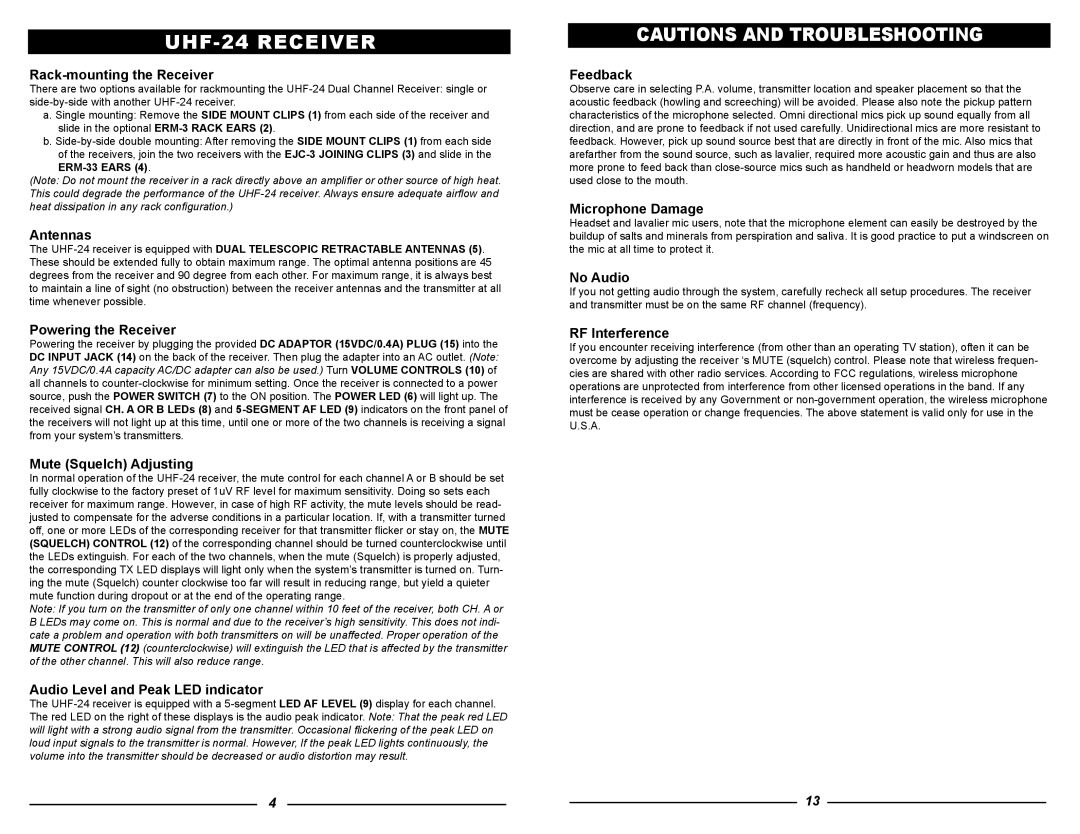
UHF-24 RECEIVER
Rack-mounting the Receiver
There are two options available for rackmounting the
a. Single mounting: Remove the SIDE MOUNT CLIPS (1) from each side of the receiver and slide in the optional
b.
(Note: Do not mount the receiver in a rack directly above an amplifier or other source of high heat. This could degrade the performance of the
Antennas
The
Powering the Receiver
Powering the receiver by plugging the provided DC ADAPTOR (15VDC/0.4A) PLUG (15) into the DC INPUT JACK (14) on the back of the receiver. Then plug the adapter into an AC outlet. (Note: Any 15VDC/0.4A capacity AC/DC adapter can also be used.) Turn VOLUME CONTROLS (10) of all channels to
Mute (Squelch) Adjusting
In normal operation of the
Note: If you turn on the transmitter of only one channel within 10 feet of the receiver, both CH. A or B LEDs may come on. This is normal and due to the receiver’s high sensitivity. This does not indi- cate a problem and operation with both transmitters on will be unaffected. Proper operation of the MUTE CONTROL (12) (counterclockwise) will extinguish the LED that is affected by the transmitter of the other channel. This will also reduce range.
Audio Level and Peak LED indicator
The
CAUTIONS AND TROUBLESHOOTING
Feedback
Observe care in selecting P.A. volume, transmitter location and speaker placement so that the acoustic feedback (howling and screeching) will be avoided. Please also note the pickup pattern characteristics of the microphone selected. Omni directional mics pick up sound equally from all direction, and are prone to feedback if not used carefully. Unidirectional mics are more resistant to feedback. However, pick up sound source best that are directly in front of the mic. Also mics that arefarther from the sound source, such as lavalier, required more acoustic gain and thus are also more prone to feed back than
Microphone Damage
Headset and lavalier mic users, note that the microphone element can easily be destroyed by the buildup of salts and minerals from perspiration and saliva. It is good practice to put a windscreen on the mic at all time to protect it.
No Audio
If you not getting audio through the system, carefully recheck all setup procedures. The receiver and transmitter must be on the same RF channel (frequency).
RF Interference
If you encounter receiving interference (from other than an operating TV station), often it can be overcome by adjusting the receiver ‘s MUTE (squelch) control. Please note that wireless frequen- cies are shared with other radio services. According to FCC regulations, wireless microphone operations are unprotected from interference from other licensed operations in the band. If any interference is received by any Government or
4 | 13 |
